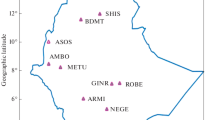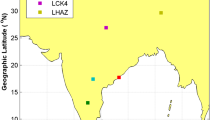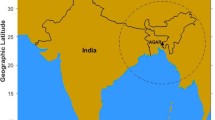Abstract
Proper characterization of total electron content (TEC) and scintillation is very important to global positioning system (GPS) users in communication, navigation, ionospheric or atmospheric studies. Quiet time variation of TEC is useful in the estimation and removal of ionospheric delay for global navigation satellite systems single-frequency positioning. During geomagnetic storms, the variations of ionosphere deviate from their quiet day pattern and can cause significant effects on short-term prediction of various ionospheric parameters. The dynamics of the ionosphere change from region to region; therefore, in order to evaluate and improve the performance of global models of the ionosphere, numerous studies of variations using measured ionospheric parameters from stations globally are useful. This paper presents for the first time variations in the TEC and scintillation at Maseno University (geomagnetic coordinates, 9.64°S, 108.59°E), Kenya, investigated using a NovAtelGSV400B GPS receiver for the high solar activity year 2014. The GPS-measured TEC values were compared with the modeled TEC values by the latest International Reference Ionosphere model (IRI-2016), with a view to evaluate the performance of this version of the model. The largest TEC values were observed from 1300 to 1500 h local time throughout the year with the largest diurnal values occurring in March equinox and smallest during June solstice. The largest TEC values are attributed to extreme ultraviolet radiation coupled with upward \(\vec{E} \times \vec{B}\) plasma drift velocity. Nighttime enhancements in TEC attributed to the ‘fountain’ effect occurred during some months. Scintillation correlated with depletions in TEC occurred in the period between 1600 h local time to 1900 h local time (post-sunset) sector during some months, with the strongest value of − 0.91 being experienced in March equinox. Scintillation was absent during geomagnetic storms studied mainly as a result of the time of onset of the recovery phases of the storms. In addition, the geomagnetic storms were manifested in GPS-measured TEC as negative ionospheric storms. The IRI-2016 model gave a good prediction of measured values except for its overestimation of measured TEC in the months of May and June. Further, a new insight shown by the results is the ability of the IRI-2016 model to predict post-sunset TEC enhancements during some months contrary to previous versions reported by other researchers in East Africa. However, model is not quickly sensitive to transitions from one season to another. This result contributes to the improvement of the current IRI model by recommending the introduction of an input into the model that is sensitive to transitions in seasons in future versions of the model.






Similar content being viewed by others
References
Anderson A, Anghel A, Chau J, Yumoto K, Battacharyya A, Alex S (2006) Daytime, low latitude, vertical ExB drift velocities, inferred from ground-based magnetometer observations in the Peruvian, Philippine and Indian longitude sectors under quiet and disturbed conditions. ILWS Workshop, Goa
Bilitza D, Altadill D, Zhang Y, Mertens C, Truhlik V, Richards P, McKinnell L-A, Reinisch B (2014) The international reference ionosphere 2012—a model of international collaboration. J Space Weather Space Clim 4:1–12
Bhattacharya S, Purohit PK, Gwal AK (2009) Ionospheric time delay variations in equatorial anomaly region during low solar activity using GPS. Indian J Radio Space Phys 38:266–274
Campbell W (2003) Introduction to geomagnetic fields, 2nd edn. Cambridge University Press, New York
Carrano SC (2007) GPS-SCINDA: a real time GPS data acquisition and ionospheric analysis system for SCINDA. Scientific Report No. X. Air Force Research Laboratory, Hanscom, USA
Dashora N, Pandey R (2005) Observations in equatorial anomaly region of total electron content enhancements and depletions. Ann Geophys 23:2449–2456
D’ujanga FM, Mubiru J, Twinamasiko BF, Basalirwa C, Ssenyonga TJ (2012) Total electron content variations in equatorial anomaly region. Adv Space Res 50:441–449
Fejer B (2002) Low latitude storm time ionospheric electrodynamics. J Atmos Solar Terr Phys 64:1401–1408
Fuller-Rowell TJ, Codrescu MV, Moffett RJ, Quegan S (1994) Response of the thermosphere and ionosphere to geomagnetic storms. J Geophys Res 99:3893–3914
Goodman JM (2005) Space weather and telecommunications. Radio Propagation Services, Inc. (RPSI), Alexandria. ISBN 0-387-23670-8
Kim E, Jee G, Kim YH (2008) Seasonal characteristics of the longitudinal wavenumber-4 structure in the equatorial ionospheric anomaly. J Astron Space Sci 25(4):335–346
Kumar S, Tan EL, Murti DS (2015) Impacts of solar activity on performance of the IRI-2012 model predictions from low to midlatitudes. Earth Planet Space 67:42. https://doi.org/10.1186/s40623-015-0205-3
Langley R, Fedrizzi M, Paula E, Santos M, Komjathy A (2002) Mapping the low latitude ionosphere with GPS. GPSWorld 13(2):41–46
Li G, Ning B, Zhao B, Liu L, Liu JY, Yumoto K (2008) Effects of geomagnetic storm on GPS ionospheric scintillations at Sanya. J Atmos Solar Terr Phys 70:1034–1045
Mannucci AJ, Wilson BD, Edwards CD (1993) A new method for monitoring the earth’s ionospheric total electron content using the GPS global network. In: Proceedings of ION GPS-93, Institute of Navigation, pp 1323–1332
Nigussie M, Radicella SM, Damtie B, Nava B, Yizengaw E, Groves K (2013) Validation of the NeQuick 2 and IRI-2007 models in East-African equatorial region. J Atmos Sol Terr Phys 102:26–33. https://doi.org/10.1016/j.jastp.2013.04.016
Olwendo OJ, Baki P, Cilliers PJ, Mito C, Doherty P (2012) Comparison of GPS TEC measurements with IRI-2007 TEC prediction over the Kenyan region during the descending phase of solar cycle 23. Adv Space Res 49:914–921
Oron S, D'ujanga FM, Ssenyonga TJ (2013) Ionospheric TEC variations during the ascending solar activity phase at an equatorial station, Uganda. Indian J Radio Space Phys 42:7–17
Oryema B, Jurua E, D’ujanga FM, Ssebiyonga N (2015) Investigation of TEC variations over the magnetic equatorial and equatorial anomaly regions of the African sector. Adv Space Res 56:1939–1950
Sharma K, Dabas RS, Sudha R (2012) Study of total electron content variations over equatorial and low latitude ionosphere during extreme solar minimum. Astrophys Space Sci. https://doi.org/10.1007/s10509-012-1133-3
Radicella SM (2009) The African Ionosphere. Satellite navigation science and technology for Africa Workshop (23rd March–9th April 2009), ICTP, Trieste, Italy
Seemala GK, Valladares CE (2011) Statistics of total electron depletions observed over South American continent for the year 2008. Radio Sci 46:RS5019. https://doi.org/10.1029/2011RS004722
Theodore LB, Paul MK (1999) Simultaneous global positioning system observations of equatorial scintillations and total electron content fluctuations. J Geophys Res 104(A10):22553–22565
Vijaya LD, Balan N, Tulasi RS, Liu JY (2011) Statistics of geomagnetic storms and ionospheric storms at low and mid latitudes in two solar cycles. J Geophys Res 116:A11328. https://doi.org/10.1029/2011JA017042
Wong A (2009) US space-based PNT international cooperation and support in Africa. Bureau of Oceans and Environmental Science Satellite Navigation Science and Technology for Africa Workshop (23rd March–9th April 2009), ICTP, Trieste, Italy
Acknowledgements
The authors are grateful to Boston College and the Air Force Research Laboratory (AFRL), USA, for installing the GPS receiver used in the present research. They also thank the anonymous reviewers for evaluating the manuscript.
Author information
Authors and Affiliations
Corresponding author
Ethics declarations
Conflict of interest
The authors declare that they have no conflict of interest.
Rights and permissions
About this article
Cite this article
Omondi, G.E., Baki, P. & Ndinya, B.O. Total electron content and scintillations over Maseno, Kenya, during high solar activity year. Acta Geophys. 67, 1661–1670 (2019). https://doi.org/10.1007/s11600-019-00354-7
Received:
Revised:
Accepted:
Published:
Issue Date:
DOI: https://doi.org/10.1007/s11600-019-00354-7




